Knowledge Models for Spatial Planning: Ecosystem Services Awareness in the New Plan of Bari (Italy)
Abstract
1. Introduction
2. Ecosystem Services in a Knowledge-Oriented Perspective: A Relevant Background
3. The Case Study of Bari
4. Methodology
4.1. Participatory Modelling Exercise: Civic Walks (CWs)
4.2. Knowledge Discovery in Text (KDT) and Causal Loop Diagram (CLD)
4.3. Problem Structuring Method: Semi-Structured Interviews
5. Results and Discussion
6. Conclusions
Author Contributions
Funding
Acknowledgments
Conflicts of Interest
References
- Venuti, G.C. La Terza Generazione Dell’urbanistica; Angeli: Milano, Italy, 1990. [Google Scholar]
- Lucci, P.; Ruzzon, D. Pianificazione Locale: L’Agenda 21 e la Nuova Generazione di Piani in Quaderni–Ambiente e Società; ISPRA: Rome, Italy, 2015; Volume 1, ISBN 978-88-448-0728-3. [Google Scholar]
- Sassen, S. Human Settlement Development; EOLSS Publications: Oxford, UK, 2009. [Google Scholar]
- Newman, P.; Jennings, I. Cities as Sustainable Ecosystems: Principles and Practices; Island Press: Washington, DC, USA, 2012. [Google Scholar]
- Chilvers, J. Environmental Risk, Uncertainty, and Participation: Mapping an Emergent Epistemic Community. Environ. Plan. 2008, 40, 2990–3008. [Google Scholar] [CrossRef]
- Binning, C.E.; Cork, S.J.; Parry, R.; Shelton, D. Natural Assets: An Inventory of Ecosystem Goods and Services in the Goulburn Broken Catchment; CSIRO Sustainable Ecosystems: Canberra, Australia, 2001. [Google Scholar]
- Millennium, M.A. Ecosystem Assessment. Ecosystems and Human Well-being: Synthesis; Island Press: Washington, DC, USA, 2005. [Google Scholar]
- Wallace, K.J. Classification of ecosystem services: Problems and solutions. Biol. Conserv. 2007, 139, 235–246. [Google Scholar] [CrossRef]
- Boyd, J.; Banzhaf, S. Ecosystem Services and Government Accountability: The need for a new way of judging Nature’s Value. Resources 2005, 158, 16–19. [Google Scholar]
- Boyd, J.; Banzhaf, S. What are ecosystem services? The need for standardized environmental accounting units. Ecol. Econ. 2007, 63, 616–626. [Google Scholar] [CrossRef]
- Landers, D.; Nahlik, A. Final Ecosystem Goods and Services Classification System (Fegs-cs). U.S.; Environmental Protection Agency: Washington, DC, USA, 2013. [Google Scholar]
- Lee, H.; Lautenbach, S. A quantitative review of relationships between ecosystem services. Ecol. Indic. 2016, 66, 340–351. [Google Scholar] [CrossRef]
- Holt, A.R.; Mears, M.; Maltby, L.; Warren, P. Understanding spatial patterns in the production of multiple urban ecosystem services. Ecosyst. Serv. 2015, 16, 33–46. [Google Scholar] [CrossRef]
- CICES. Available online: https://biodiversity.europa.eu/maes/ecosystem-services-categories-in-millennium-ecosystemassessment-ma-the-economics-of-ecosystem-and-biodiversity-teeb-and-common-international-classification-of-ecosystem-services-cices (accessed on 26 May 2019).
- EPA. United States Environmental Protection Agency. Available online: https://www.epa.gov/enviroatlas/ecosystem-services-enviroatlas (accessed on 15 April 2019).
- Vogdrup-Schmidt, M.; Strange, N.; Olsen, S.B.; Thorsen, B.J. Trade-off analysis of ecosystem service provision in nature networks. Ecosyst. Serv. 2017, 23, 165–173. [Google Scholar] [CrossRef]
- Fisher, B.; Turner, R.; Morling, P. Defining and classifying ecosystem services for decision making. Ecol. Econ. 2009, 68, 643–653. [Google Scholar] [CrossRef]
- Pedersen Zari, M. Ecosystem services analysis for the design of regenerative built environments. Build. Res. Inf. 2012, 40, 54–64. [Google Scholar] [CrossRef]
- Raymond, C.M.; Kenter Jasper, O. Transcendental values and the valuation and management of ecosystem services. Ecosyst. Serv. 2016, 21, 241–257. [Google Scholar] [CrossRef]
- Holling, C.S. Understanding the complexity of economic, ecological and social systems. Ecosystems 2001, 4, 390–405. [Google Scholar] [CrossRef]
- Armsworth, P.R.; Chan, K.M.A.; Daily, G.C.; Ehrlich, P.R.; Kremen, C.; Ricketts, T.H.; Sanjayan, M.A. Ecosystem service science and the way forward for conservation. Conserv. Biol. 2007, 21, 1383–1384. [Google Scholar] [CrossRef] [PubMed]
- Ascough, J.C.; Maier, H.R.; Ravalico, J.K.; Strudley, M.W. Future research challenges for incorporation of uncertainty in environmental and ecological decision-making. Ecol. Model. 2008, 219, 383–399. [Google Scholar] [CrossRef]
- Hansen, R.; Frantzeskaki, N.; McPhearson, T.; Rall, E.; Kabisch, N.; Kaczorowska, A.; Kain, J.H.; Artmann, M.; Pauleit, S. The uptake of the ecosystem services concept in planning discourses of European and American cities. Ecosyst. Serv. 2015, 12, 228–246. [Google Scholar] [CrossRef]
- Fischer, F. Citizens, Experts, and the Environment: The Politics of Local Knowledge; Duke University Press: Durham, NC, USA, 2000. [Google Scholar]
- Barreteau, O.; Bots, P.W.G.; Daniell, K.A. A framework for clarifying “participation” in participatory research to prevent its rejection for the wrong reasons. Ecol. Soc. 2010, 15, 1–22. [Google Scholar] [CrossRef]
- Maskrey, S.A.; Mount, N.J.; Thorne, C.R.; Dryden, I. Participatory modelling for stakeholder involvement in the development of flood risk management intervention options. Environ. Model. Softw. 2016, 82, 275–294. [Google Scholar] [CrossRef]
- Pagano, A.; Pluchinotta, I.; Pengal, P.; Cokan, B.; Giordano, R. Engaging stakeholders in the assessment of NBS effectiveness in flood risk reduction: A participatory System Dynamics Model for benefits and co-benefits evaluation. Sci. Total Environ. 2019, 690, 543–555. [Google Scholar] [CrossRef]
- PPTR. Piano Paesaggistico Territoriale Regionale; General Report; Regione Puglia: Puglia, Italy; Available online: http://paesaggio.regione.puglia.it/PPTR_2015/1_Relazione%20Generale/01_Relazione%20Generale.pdf (accessed on 12 February 2020).
- Satterfield, T.; Roberts, M. Incommensurate risks and the regulator’s dilemma: Considering culture in the governance of genetically modified organisms. New Genet. Soc. 2008, 27, 201–216. [Google Scholar] [CrossRef]
- PUG Report. Available online: http://pug.comune.bari.it/report/ (accessed on 20 June 2019).
- Jones, B. Neighborhood Planning. A Guide for Citizens and Planner; American Planning Association: Chicago, IL, USA, 1990. [Google Scholar]
- Fagence, M. Citizen Participation in Planning; Elsevier: Amsterdam, The Netherlands, 2014. [Google Scholar]
- Borri, D.; Camarda, D.; De Liddo, A. Envisioning environmental futures: Multi-agent knowledge generation, frame problem, cognitive mapping. Lect. Notes Comput. Sci. 2004, 3190, 230–237. [Google Scholar] [CrossRef]
- Brody, S.D.; Godschalk, D.R.; Burby, R.J. Mandating citizen participation in plan making: Six strategic planning choices. J. Am. Plan. Assoc. 2003, 69, 245–264. [Google Scholar] [CrossRef]
- Berthet, E.T.A.; Barnaud, C.; Girard, N. How to foster agroecological innovations? A comparison of participatory design methods. J. Environ. Plan. Manag. 2016, 59, 280–301. [Google Scholar] [CrossRef]
- Hatchuel, A.; Weil, B. C-K design theory: An advanced formulation. Res. Eng. Des. 2009, 19, 181. [Google Scholar] [CrossRef]
- Borri, D.; Camarda, D. Spatial ontologies in multi-agent environmental planning. In Technologies for Supporting Reasoning Communities and Collaborative Decision Making: Cooperative Approaches; Yearwood, J., Stranieri, A., Eds.; IGI Global Information Science: Hershey, PA, USA, 2010; pp. 272–295. [Google Scholar]
- Tsoukiàs, A.; Pluchinotta, I.; Ferretti, V. Studying the generation of alternatives in public policy making processes. Eur. J. Oper. Res. 2019, 273, 353–363. [Google Scholar] [CrossRef]
- Homer, J.; Oliva, R. Maps and models in system dynamics: A response to Coyle. Syst. Dyn. Rev. 2001, 17, 347–355. [Google Scholar] [CrossRef]
- Schröter, M.; Kraemer, R.; Mantel, M.; Kabisch, N.; Hecker, S.; Richter, A.; Neumeier, V.; Bonn, A. Citizen science for assessing ecosystem services: Status, challenges and opportunities. Ecosyst. Serv. 2017, 28, 80–94. [Google Scholar] [CrossRef]
- Lynam, T.; De Jong, W.; Sheil, D.; Kusumanto, T.; Evans, K. A review of tools for incorporating community knowledge, preferences, and values into decision making in natural resources management. Ecol. Soc. 2007, 12, 5. [Google Scholar] [CrossRef]
- Daniell, K.A. Co-Engineering Participatory Modelling Processes for Water Planning and Management. Ph.D. Thesis, Agro Paris Tech. and the Australian National University, Canberra, Australia, 2008. [Google Scholar]
- Voinov, A.; Bousquet, F. Modelling with stakeholders. Environ. Model. Softw. 2010, 25, 1268–1281. [Google Scholar] [CrossRef]
- Hare, M. Forms of Participatory Modelling and its Potential for Widespread Adoption in the Water Sector. Environ. Policy Gov. 2011, 21, 386–402. [Google Scholar] [CrossRef]
- Dulli, S.; Polpettini, P.; Trotta, M. Text Mining: Teoria e Applicazioni; Franco Angeli: Milano, Italy, 2004. [Google Scholar]
- Bolasco, S.; Canzonetti, A.; Capo, F. Text Mining—Uno Strumento Strategico per Imprese e Istituzioni; Cisu Editore: Roma, Italy, 2005. [Google Scholar]
- Rapid Miner Studio Software. Available online: https://rapidminer.com/get-started/ (accessed on 30 November 2019).
- Verma, T. Processo di tokenizzazione e filtro in RapidMiner. IJAIS 2014, 7, 16–18. [Google Scholar] [CrossRef]
- Exter, K.; den Specht, A. Assisting stakeholder decision making using system dynamics group model-building. In Proceedings of APEN National Forum; The Regional Institute: Hobart, Australia, 2003; p. 43. [Google Scholar]
- Vennix, J.A.M.; Akkermans, H.A.; Rouwette, E.A.J.A. Group model-building to facilitate organizational change: An exploratory study. Syst. Dyn. Rev. 1996, 12, 39–58. [Google Scholar] [CrossRef]
- Richardson, G.P. Loop polarity, loop dominance, and the concept of dominant polarity. Syst. Dyn. Rev. 1995, 11, 67–88. [Google Scholar] [CrossRef]
- Fruchterman, T.M.J.; Reingold, E.M. Graph Drawing by Force-Directed Placement. Softw. Pract. Exp. 1991, 21, 1129–1164. [Google Scholar] [CrossRef]
- Barriball, K.L.; While, A. Collecting data using a semi-structured interview: A discussion paper. J. Adv. Nurs. 1994, 19, 328–335. [Google Scholar] [CrossRef] [PubMed]
- Wilson, C. Interview Techniques for UX Practitioners: A User-Centered Design Method; Newnes Publications: Newton, MA, USA, 2013. [Google Scholar]
- Freitag, D. Machine Learning for Information Extraction in Informal Domains; Carnegie Mellon University Press: Pittsburgh, PA, USA, 1998. [Google Scholar]
- Liu, B. Sentiment Analysis and Opinion Mining; Morgan & Claypool: London, UK, 2012. [Google Scholar]
- De Roo, P.G.; Silva, E.A. A Planner’s Encounter with Complexity; Ashgate Publishing Limited: Farnham, Surrey, UK, 2010. [Google Scholar]
- Simon, H. Trial and error search in solving difficult problems. Behav. Sci. 1962, 7, 425–429. [Google Scholar] [CrossRef]
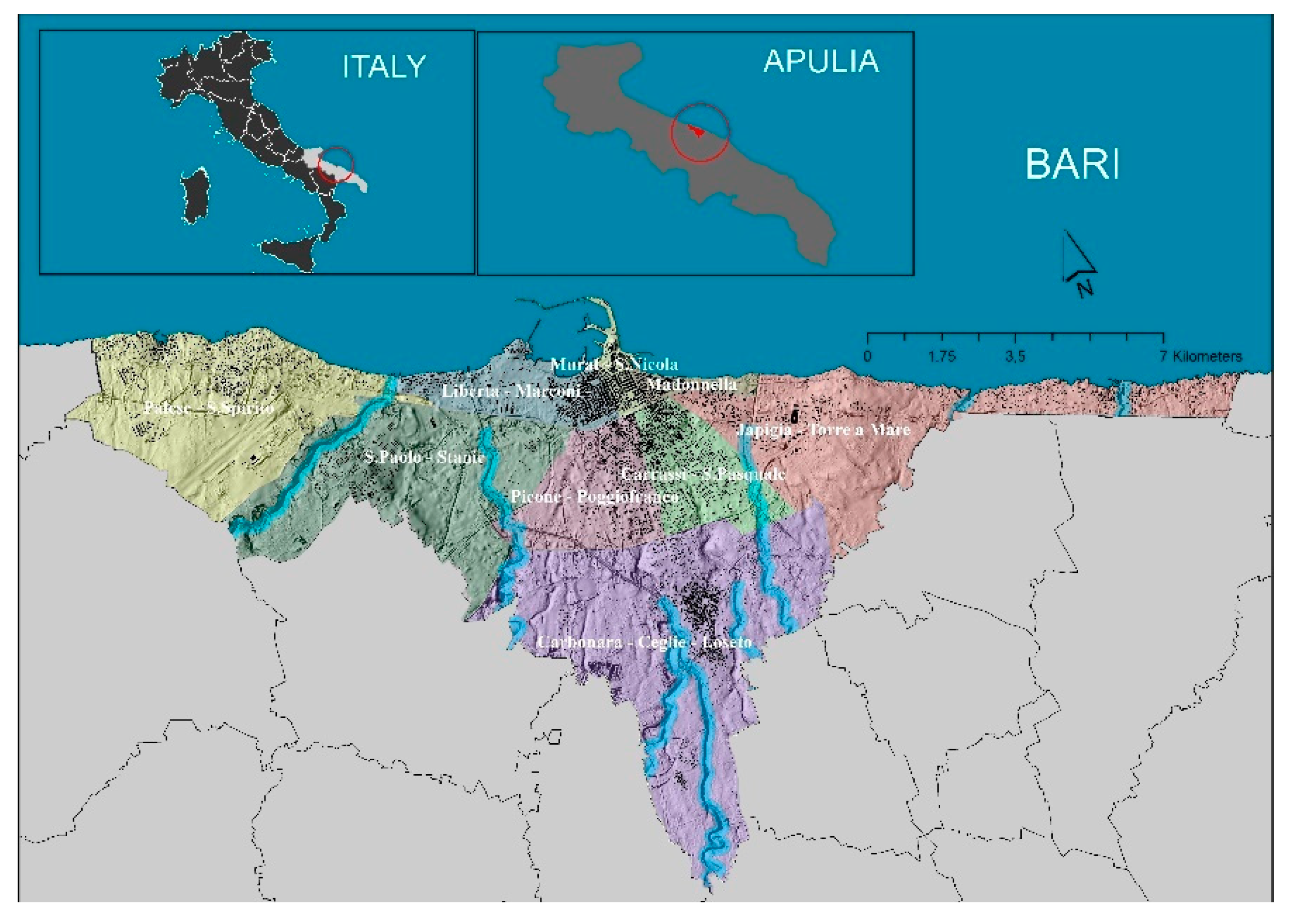
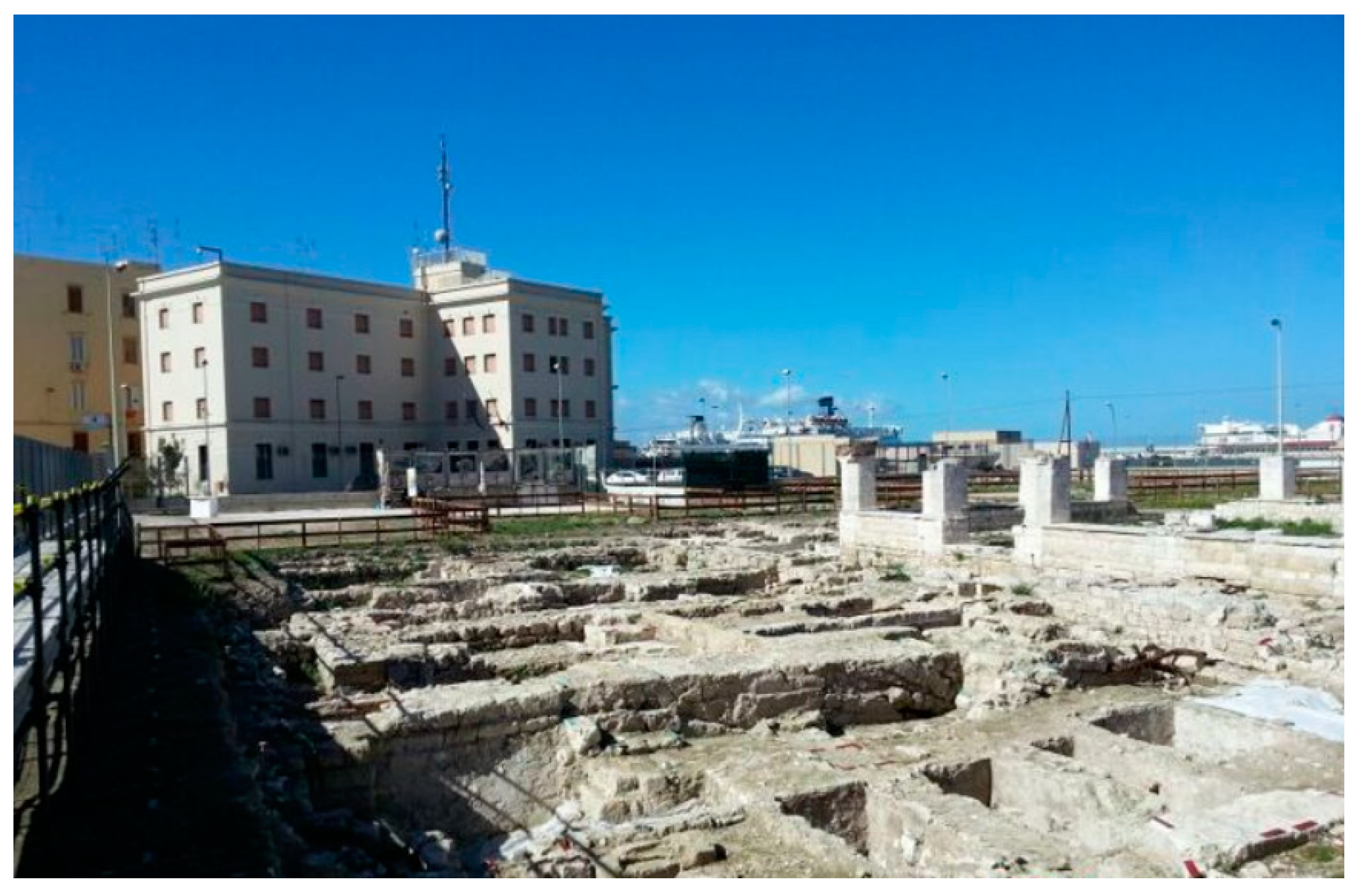

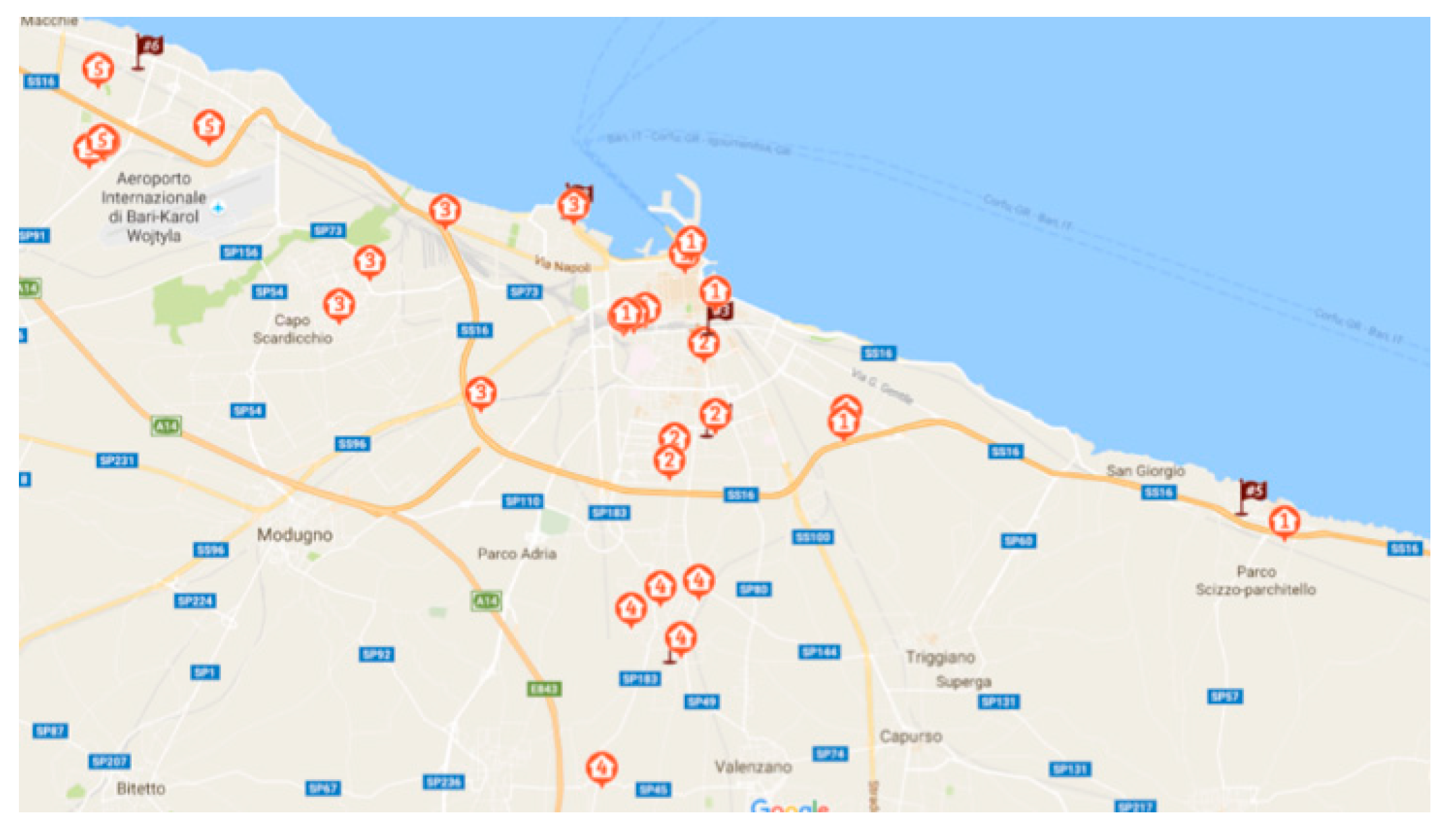

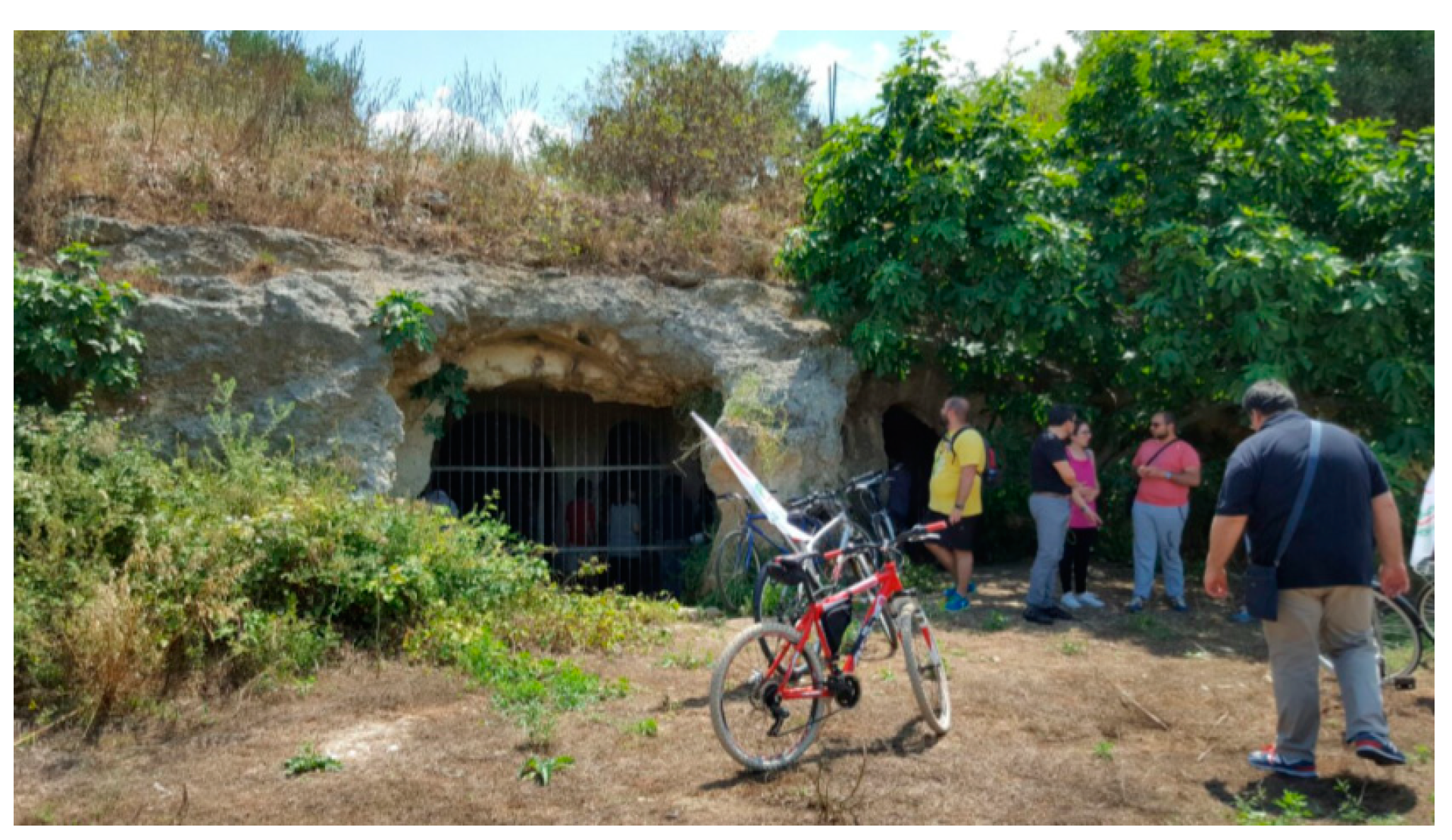

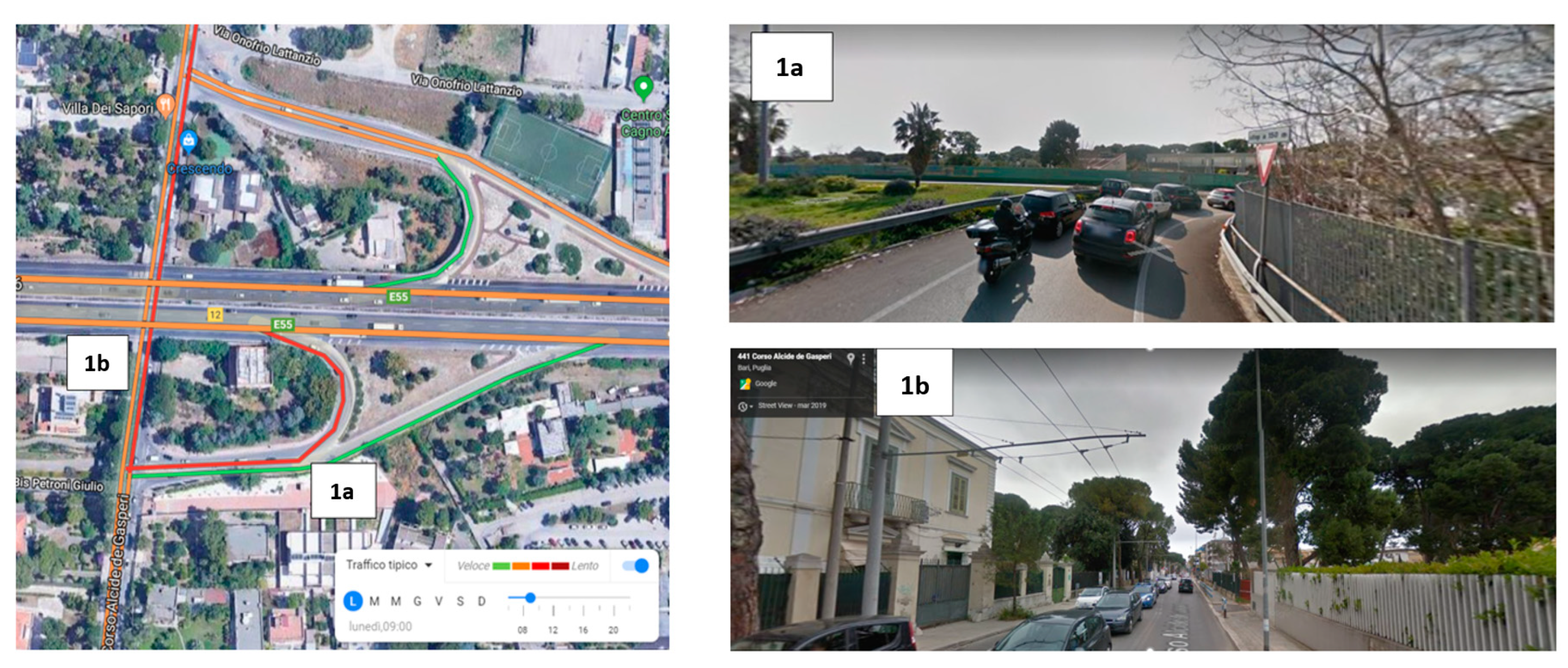
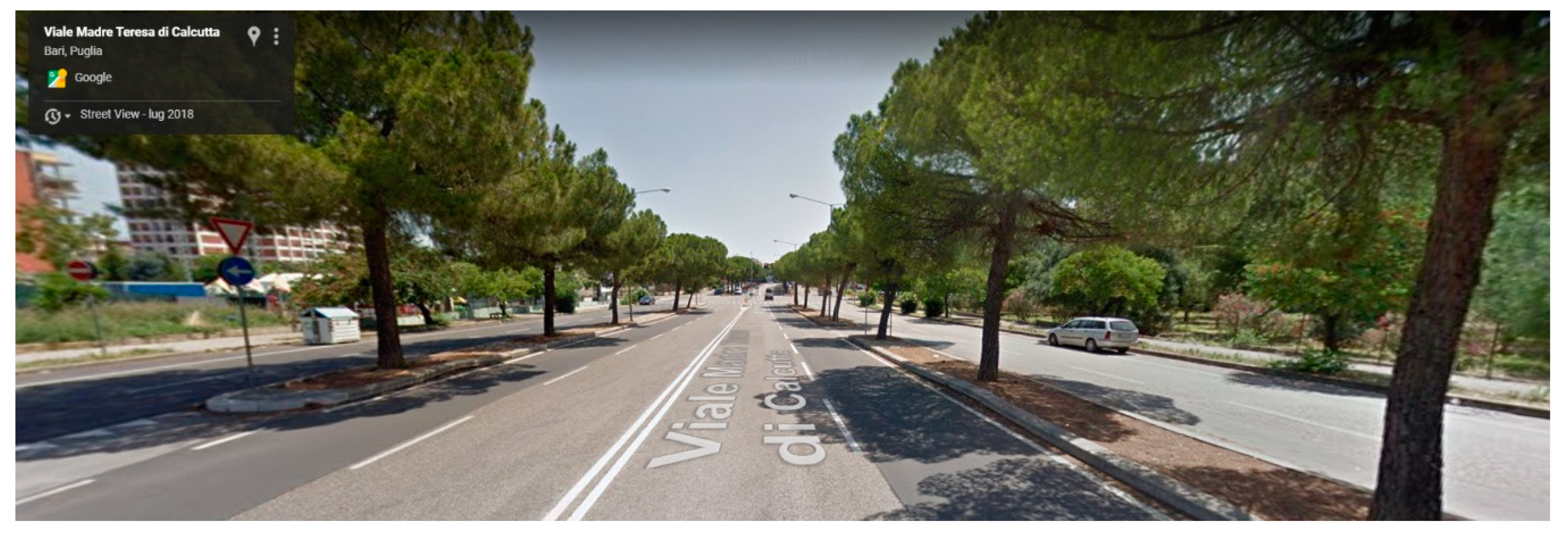
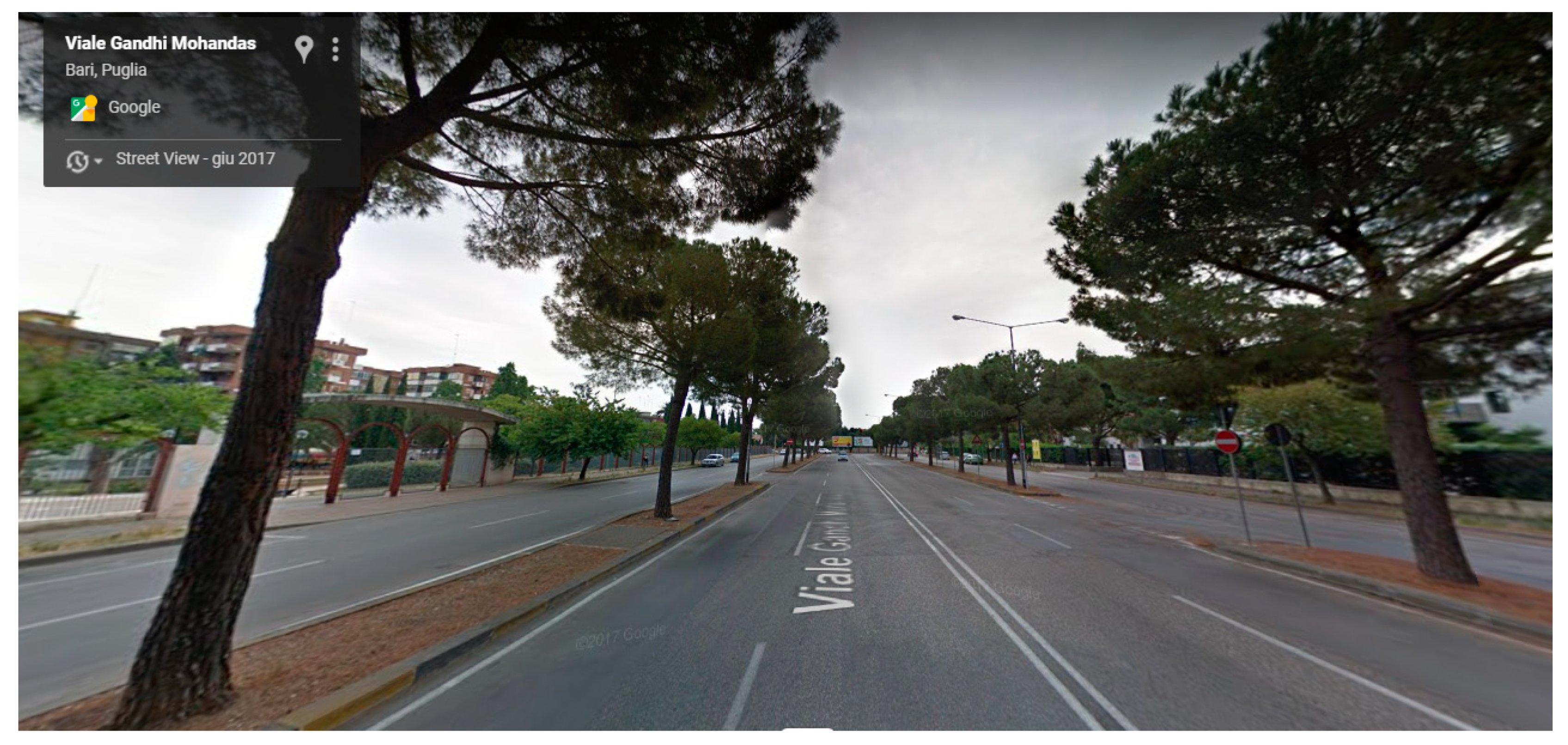

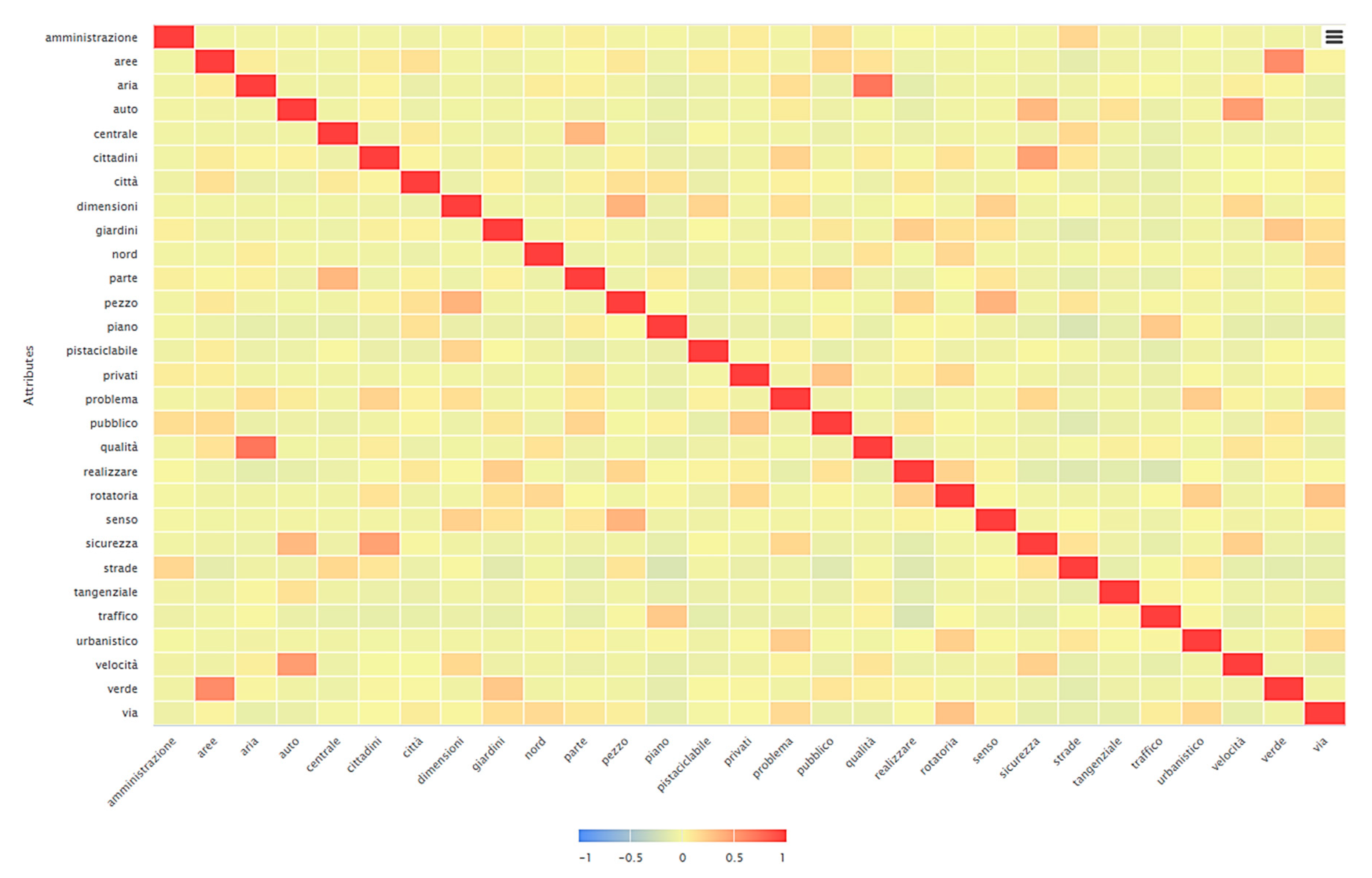

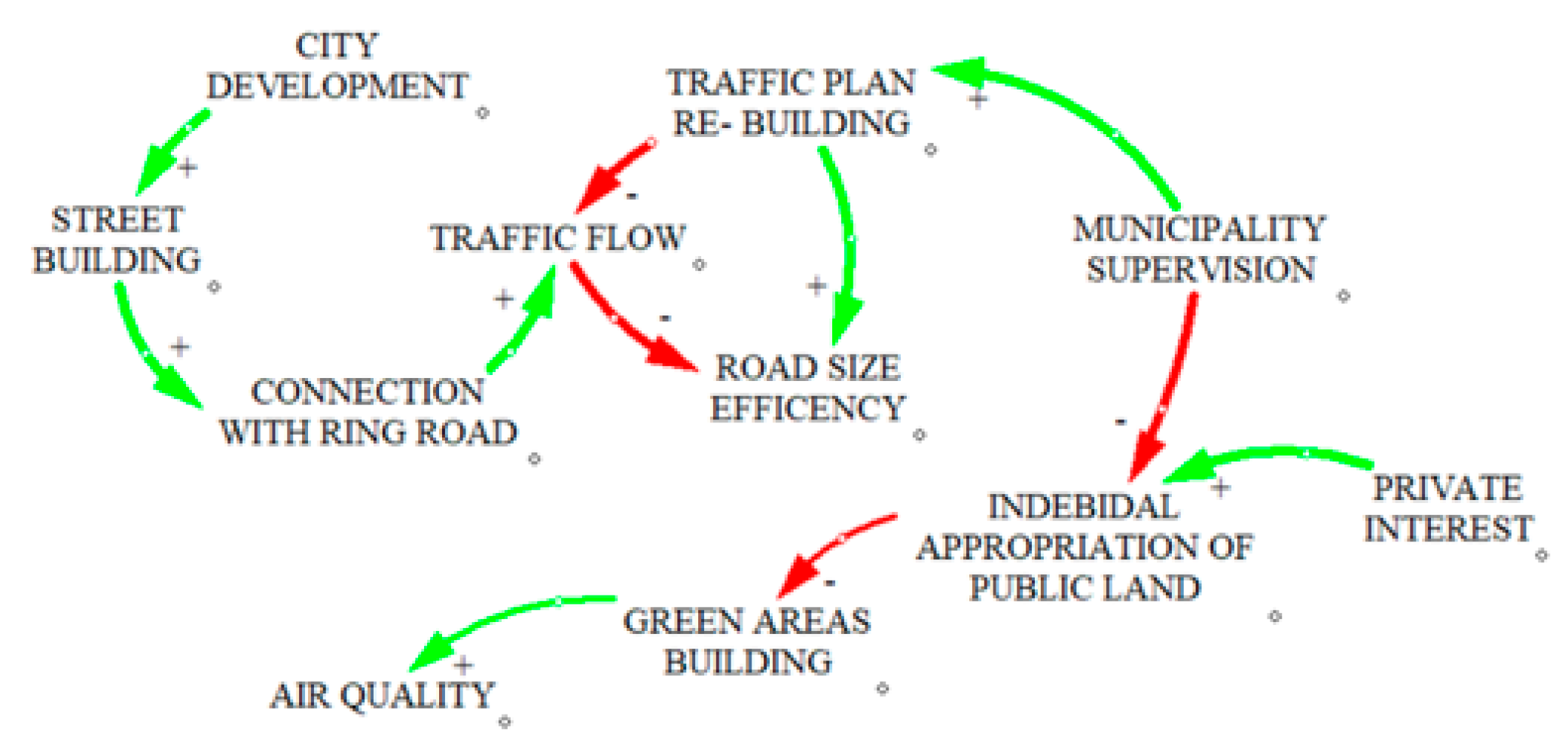
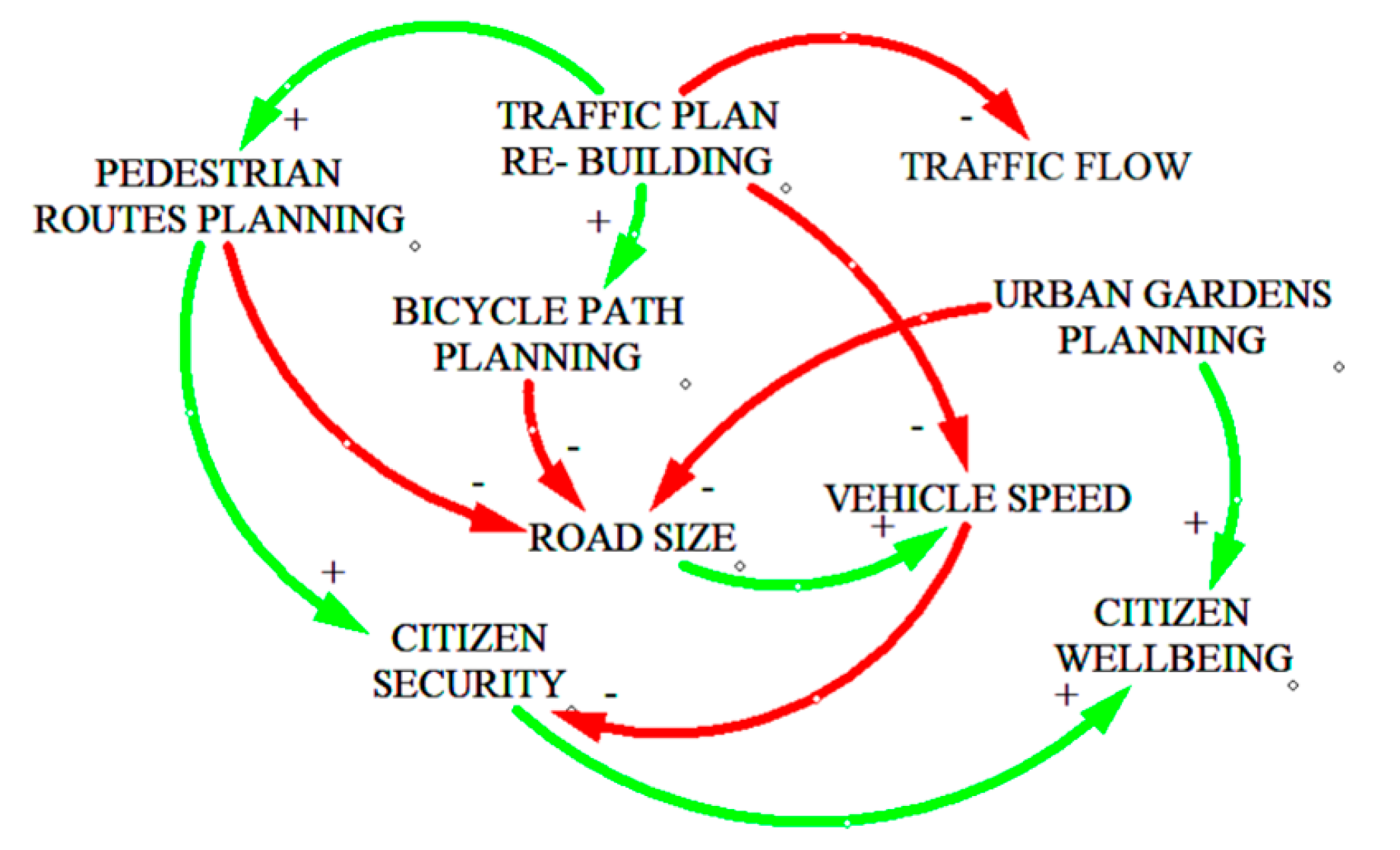
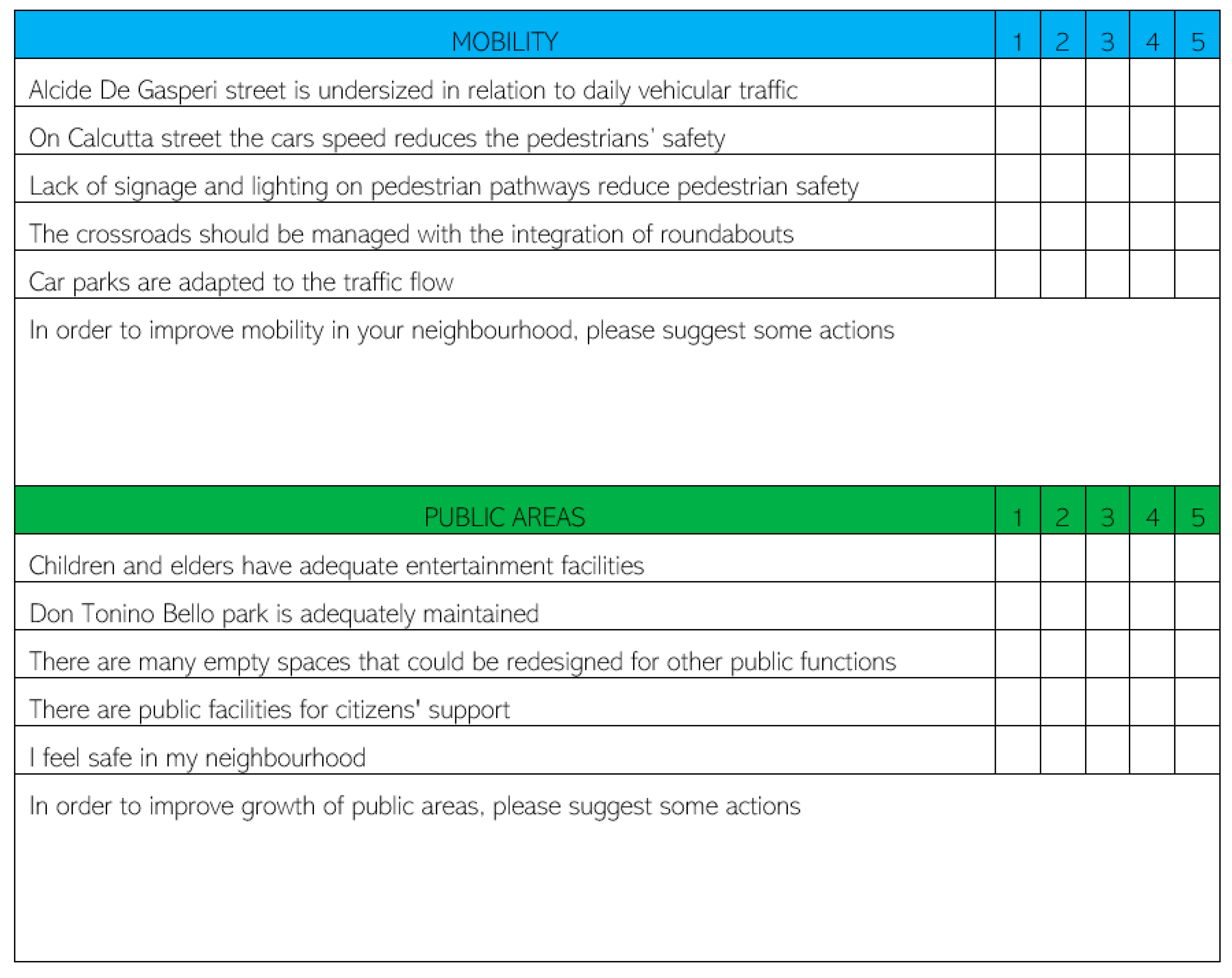

| ECOSYSTEM SERVICES | ||
|---|---|---|
| NATURAL RESOURCES | DRIVERS OF CHANGE | BENEFITS |
| Water | Policy | Economy |
| Land | Land Use | Well-being |
| Soil | Climate | Food- Water and Materials |
| Air | Pollution | Public Health |
| Subject of Civic Walks | Areas |
|---|---|
| 1. Minor historical centers and hypogea | Carbonara e Ceglie |
| 2. Relations between the city and the sea | Libertà e Marconi |
| 3. The places of the “gigantism” of the Quaroni Plan and the city of children | Carrassi e Poggiofranco |
| 4. The reuse and redevelopment of historical fabrics in the multiethnic city | Madonnella e Libertà |
| 5. Archaeological protection as a natural barrier to the consumption of soil and a resource for development | Torre a Mare |
| 6. Recovery of brownfield areas | Santo Spirito |
| 7. The historical nucleuses of public buildings and the landscape resources in the suburbs | San Paolo |
| 8. The quality of living in the large public housing districts: public space and private space in the different neighborhood settlements | Japigia |
| 9 The public housing districts to be reconnected | Stanic |
| Typology | Description | Tool |
|---|---|---|
| Group Model Building (GMB) | It is based on the involvement of a group of stakeholders in order to create a conceptual model. The model building process can start from a story telling, a set of interviews or narratives and it is supported by a facilitator. | Causal cycle diagrams and similar visual tools |
| Mediated Modelling (MM) | It is based on the collect of information by a group of stakeholders in order to create a system dynamic model. The model building process use the computer models in order to create scenarios. | System dynamic model (Stella) |
| Companion Modelling (CM) | It is based on involving stakeholders through role-plays in order to make them aware of the variety of points of view and their consequences in terms of actions. | Role-playing games |
| Participatory Simulation (PS) | It is based on involving stakeholder through mobile devices and physical activities. The rules of the games cannot be modified by the stakeholders. Every decision and every interaction are registered for further analyses. | Agent-based model |
| Shared Vision Planning (SVP) | It is based on computer simulation in order to identify alternatives and trade-offs in a manner where stakeholders without modelling experience can actively participate in the modelling process. | Scenario simulation |
| Collaborative Learning (CL) | It is based on the idea that learning is a naturally social act that takes place through communication. The aim is to teach and learn in groups to work together on problems, complete a task, or create a product. | Workshop, seminar, and similar tool |
| NATURAL RESOURCES | PLACE | DRIVERS OF CHANGE | BENEFITS | ||
|---|---|---|---|---|---|
| Policy | Land Use | Well-Being | Public Health | ||
| LAND | 1 | Municipality supervision | traffic plan re- building | decrease traffic flow | increase air quality |
| use of public green area | areas for children | ||||
| 2/3 | traffic plan re- building | increase bicycle path planning | decrease vehicles speed | ||
| increase pedestrian route planning | |||||
| decrease traffic flow | |||||
| urban gardens planning | increase citizen well-being | ||||
| NATURAL RESOURCES | PLACE | DRIVERS OF CHANGE | BENEFITS | ||
|---|---|---|---|---|---|
| Policy | Land Use | Well-Being | Public Health | ||
| Land | 1 | Planting of different tree species | Decrease of allergies | ||
| 2/3 | public lighting | pedestrian security | |||
| waste management | neighborhood cleaning | increase air quality | |||
© 2020 by the authors. Licensee MDPI, Basel, Switzerland. This article is an open access article distributed under the terms and conditions of the Creative Commons Attribution (CC BY) license (http://creativecommons.org/licenses/by/4.0/).
Share and Cite
Santoro, S.; Balena, P.; Camarda, D. Knowledge Models for Spatial Planning: Ecosystem Services Awareness in the New Plan of Bari (Italy). Sustainability 2020, 12, 1516. https://doi.org/10.3390/su12041516
Santoro S, Balena P, Camarda D. Knowledge Models for Spatial Planning: Ecosystem Services Awareness in the New Plan of Bari (Italy). Sustainability. 2020; 12(4):1516. https://doi.org/10.3390/su12041516
Chicago/Turabian StyleSantoro, Stefania, Pasquale Balena, and Domenico Camarda. 2020. "Knowledge Models for Spatial Planning: Ecosystem Services Awareness in the New Plan of Bari (Italy)" Sustainability 12, no. 4: 1516. https://doi.org/10.3390/su12041516
APA StyleSantoro, S., Balena, P., & Camarda, D. (2020). Knowledge Models for Spatial Planning: Ecosystem Services Awareness in the New Plan of Bari (Italy). Sustainability, 12(4), 1516. https://doi.org/10.3390/su12041516





